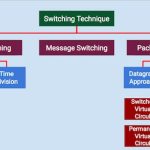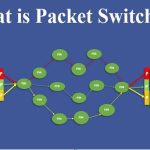In this switching method, a different strategy is used, where instead of establishing a dedicated physical line between the sender and the receiver, the message is sent to the nearest directly connected switching node. This node stores the message, checks for errors, selects the best available route and forwards the message to the next intermediate node.

Message Switching Technique
The line becomes free again for other messages, while the process is being continued in some other nodes. Due to the mode of action, this method is also known as store-and-forward technology where the message hops from node to node to its final destination. Each node stores the full message, checks for errors and forwards it.
In this switching technique, more devices can share the network bandwidth, as compared with circuit switching technique. Temporary storage of message reduces traffic congestion to some extent. Higher priority can be given to urgent messages, so that the low priority messages are delayed while the urgent ones are forwarded faster. Through broadcast addresses one message can be sent to several users. Last of all, since the destination host need not be active when the message is sent, message switching techniques improve global communications.
However, since the message blocks may be quite large in size, considerable amount of storage space is required at each node to buffer the messages. A message might occupy the buffers for minutes, thus blocking the internodal traffic.
Basic idea:
· Each network node receives and stores the message
· Determines the next leg of the route, and
· Queues the message to go out on that link.
Advantages:
· Line efficiency is greater (sharing of links).
· Data rate conversion is possible.
· Even under heavy traffic, packets are accepted, possibly with a greater delay in delivery.
· Message priorities can be used, to satisfy the requirements, if any.
Disadvantages:
· Message of large size monopolizes the link and storage


